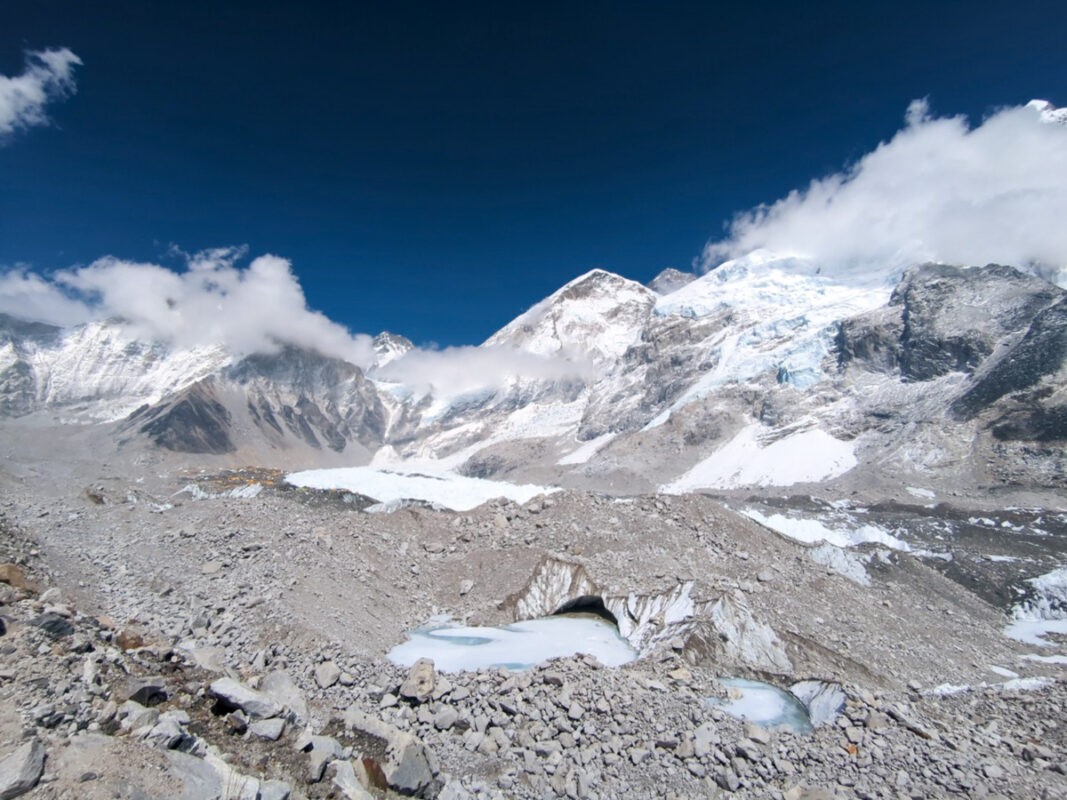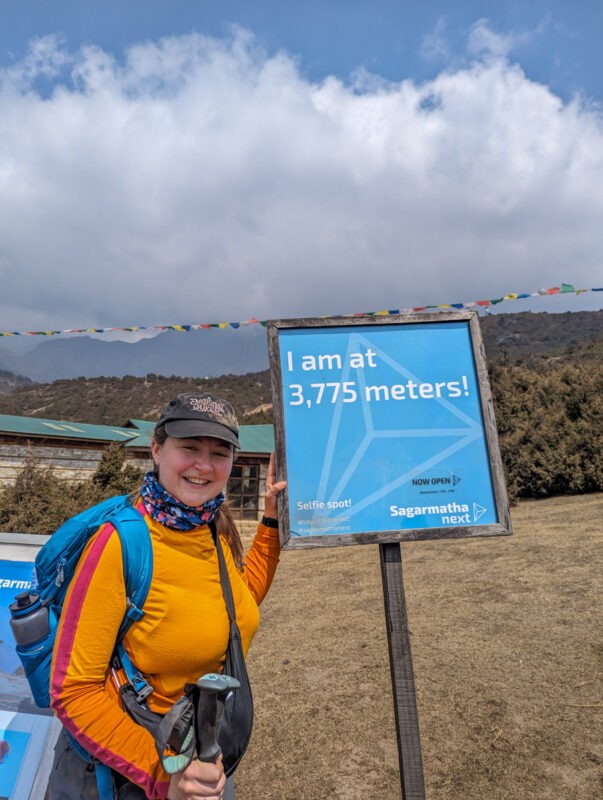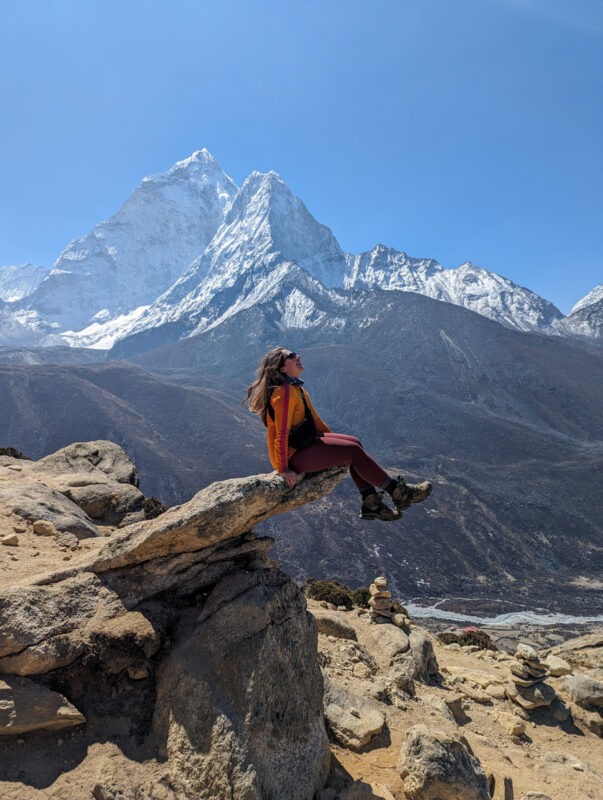Are you planning to hike Everest Base Camp?
I recently returned from the EBC hike, and I put together a few top travel tips to help you with your trip planning.
These are the things I wish I knew before doing the hike!
Top Everest Base Camp tips from my trip to Nepal!
If you’re planning to hike Everest Base Camp, here’s my best advice!
1. It’s best to go with a guide

Technically, you don’t have to go with a guide when trekking in the Everest region (you do, however, need a guide for hiking in any other region of Nepal).
However, I couldn’t imagine doing the EBC hike without a guide.
Largely, this is due to altitude sickness and the very present risk that you may need help getting down from a higher altitude.
Our guide told us that in 40% of groups, somebody is heli-evacuated (someone in our group was), and only 70% of people who start the EBC hike make it to base camp itself (this includes people who stop at lower altitudes and walk down).
Dealing with this on your own would be incredibly stressful! I was unwell for one night on the Everest Base Camp trek (which may have been minor altitude sickness that I got over, or it could have been a stomach bug) and just having the guides there, with their knowledge of altitude sickness, made me feel a lot more comforted.
We went with Nepal Hiking Adventure, and I was very happy with their service and price.
2. You can buy pretty much all gear in Thamel

Don’t worry if you don’t have the right gear for the trek!
You can buy pretty much everything in Thamel in Kathmandu.
This is my full list of everything I packed for the hike – generally, I think I packed quite well while still being under the weight limit for the flights and porters – but I could have purchased all of the trekking gear in the hiking shops in Thamel.
I ended up spending around £60 for all of the following items:
- Sleeping bag liner
- Two long sleeve tops (knockoff North Face)
- Waterproof sleeping bag cover
- Down jacket (which was SO warm!)
- Extremely warm down slippers (that literally looked like sleeping bags for my feet)
I also spent $30 on sleeping bag rental (down jackets are also rentable).
3. Train at altitude if you can
While I’m quite an avid hiker, in all honesty, I found the Everest Base Camp hike more difficult than I thought I would.
This was probably because I was unwell for the three weeks before; I was diagnosed with GERD (gastro-oesophagal reflux disease) and it then gave me laryngitis!
However, one thing that I wish I’d incorporated more into my training was going to altitude. I live at sea level – and nowhere in the UK is really at altitude anyway – so I would have had to go overseas for this.
But, if you can, I highly recommend doing a couple of hikes at altitude (preferably over 2,500 metres) in the month before your trek. Of course, this hugely depends on where you are in the world and if you can reach mountains, but it’ll help a lot!
4. And practice hills!
In all honesty, while the EBC terrain isn’t easy, it’s much less steep than say, the South West Coast Path in England (the combined metres gained when walking the coast path is actually akin to summitting Everest four times!).
But being able to tackle hills will help your body a lot when dealing with other issues, like altitude! There are a couple of sections – just before Namche Bazar and just before Tengbouche Monastery – that are pretty steep and relentless for a couple of hours and the more you can practice for these, the better.
Please don’t tackle EBC with no training. Provided you don’t get altitude sickness, you may still make it, but it won’t be fun at all!
5. You can leave a LOT in Kathmandu

As we were spending some time travelling around Nepal, we had trekking and non-trekking gear and clothes.
Don’t try to bring anything with you to the mountains that you don’t need; you only have a 15kg allowance for the flight to Lukla (including hand luggage) and the lighter you can make your bag, the easier for the porters.
If you’re hiking with a company, they should give you a duffel bag to put your hiking gear in. We left our suitcases with the rest of our clothes in Kathmandu; as we stayed in the same hotel when we returned, they were happy to keep it.
We stayed in the Kailash Kutee Hotel, which had a section where bags were stored when people were away. However, I probably wouldn’t recommend staying with them (there was a blood stain on my duvet when we checked in and extremely noisy building works started outside at 5am!).
6. Don’t eat meat

All tour operators recommend that tourists stay away from meat on the trail.
You can get it even as high as Gorak Shep, but it’s carried up in baskets without refrigeration, and may not be cooked how you’re used to it.
Everybody in our group ate vegetarian past Lukla – I’m veggie anyway so it didn’t make a difference to me.
7. Pack some chocolate bars/ snacks that you know you’ll like
I genuinely thought I’d be ok with the food on the EBC trail. There were plenty of vegetarian options and usually, I can eat curry every day without getting sick of it.
This was until I was actually sick, and the idea of eating another dal baht (even though they are very good!) turned my stomach.
I’d highly recommend packing chocolate bars and other snacks to see you through. EBC isn’t the time to be on a health kick – you’re burning so many calories as it is – pack the Mars bars, and enjoy one or two a day!
Like all items, if you wait to buy these on the trail, you’ll pay a lot extra.
I’d recommend purchasing them in Kathmandu or, even better, stocking up with your favourite snacks in your home country before departing.
8. Don’t forget toilet paper!
Something else that you’ll pay through the nose for is toilet paper!
No tea houses or public restrooms have toilet rolls, so you have to bring your own.
We completely forgot to bring some from our home country and Kathmandu and ended up paying 100 rupees (just less than a dollar) per roll in Lukla, 200 rupees in Namche Bazar and 300 rupees in Lobuche. It definitely adds up!
9. Stop and see the sights along the way

It’s mostly about the hiking, but not entirely!
There are some incredible stops that you can take on the EBC trail that make for excellent hiking breaks.
These include:
- Sagarmatha National Park Museum near Namche Bazar – this also may be the first place you catch a view of Everest.
- Everest View Hotel near Namche Bazar – we went here for a tea, although it was by far the most expensive and worst tea we had!
- Tengbouche Monastery – this is a beautiful place of worship, if you see one of the monks they’ll give you a blessing
- Dingboche’s bakeries – we spent an afternoon at Cafe 4410, which even had oat milk! They put the Everest film on for us and were happy for us to stay there for hours.
- Climber’s Memorial – this is a poignant homage to people who’ve lost their lives summiting to the top of Everest.
- Lobouche Base Camp – this is much smaller than EBC but worth seeing from a distance!
10. Fuel your body as much as possible at low altitudes
One of the more minor effects of altitude sickness, that pretty much everyone in our group had, was loss of appetite.
It’s hard to force a meal that you don’t want down at 5,000 metres, but do try – and also try to eat plenty at lower altitudes when you still have an appetite (and aren’t completely sick of tea house food!).
12. Come equipped with Diamox

Diamox is a medication that helps with altitude sickness. My partner and I took it, along with another couple of people in our party, although others didn’t.
I’m not here to give medical advice, but I would probably recommend that most people have Diamox just in case (it’s not suitable for everybody, so I’d recommend speaking to a doctor or pharmacist before purchasing it).
When I felt a bit wobbly, I did find that I was vastly improved after taking Diamox. Whether it was altitude sickness that I/ the tablets dealt with or a stomach bug that improved, I don’t know, but I’m glad I had it and took it!
However, do be aware that there are side effects – for example, you need to drink a lot of water to ensure your kidney functions correctly.
You can purchase it in Kathmandu, although the pharmacist there won’t check with your medical background; we bought us back in the UK with Boots online pharmacy.
13. Make sure you have more than adequate insurance!
The most important thing is that you have fully comprehensive insurance for trekking to above 5,500 metres and heli evac.
We spent a while trying to find the right policy and went with True Traveller. They cost around £200 for insurance for the three weeks, but they specialise in comprehensive EBC insurance.
With heli evac costing at least $5,000 (plus any treatment in Kathmandu), this is not something you want to be scrimping on.
14. Bring a water-to-go bottle
You can’t drink tap water on the EBC trek, so I’d highly recommend bring a water-to-go bottle for clean drinking water.
I used mine throughout the trail; I had a couple of mineral water bottles that I’d fill with tap water and then refill my Water to Go bottle to drink from.
15. Buy a local SIM in Kathmandu
Most of the trail does have data; to have the best coverage (and to save a lot of money!), I recommend buying a local SIM in Kathmandu.
You’ll need your passport to do so and will have to swap out your SIM (unless your phone has dual SIM capability), but eSIM cards are expensive in Nepal (1GB of data was $9.50 on Airalo!).
Alternatively, you can purchase WiFi with Everest Link at all guesthouses, although the price of this does add up.
Or, you can take a digital detox and enjoy disconnecting for 10 days!
16. Bring a set of “non-hiking” clothes

One of the things I was SO glad I did on the trek was having clothes that I NEVER hiked in.
I kept these in a dry bag, and while they did get a bit mucky by the end of the trek, they were nowhere near as smelly as my hiking clothes!
It consisted of tracksuit bottoms, a fluffy jumper, a T-shirt and fluffy socks and my down slippers. When I arrived at the teahouses, I’d typically have a wet wipe wash, get changed into these and sleep in them.
Also, I’d recommend bringing a hot water bottle. This costs to fill up – it was 500 rupees in the highest tea houses – but it kept me so warm at night!
17. Know the first signs of altitude sickness and act accordingly if you get ill

While your guides can help you with altitude sickness (and if you don’t have guides, people in the tea houses will assist you), only you know how you’re feeling, so make sure you check in properly with yourself.
Early signs of altitude sickness include:
- Nausea and vomiting
- Dizziness
- Headache, typically around the back of your head
As mentioned, I did vomit once and had a headache on multiple occasions. I was told that because I only vomited once and felt better and my headaches were all at the front of my head, in a place that’s normal for me, I was likely ok – but it was good to get the peace of mind.
Symptoms of AMS can include things like disorientation, hallucinations and more severe altitude sickness symptoms, and they’re signs that you need to get off the mountain.
If you’re hiking with guides, they should have a blood oxygen monitor – you can also pick these up for relatively cheap prices if you want to have your own one. This is often a good indicator of AMS and whether you need to descend.
So, are you ready to visit Everest Base Camp?
I hope these tips have helped you with your trip planning!
I have plenty more Everest Base Camp posts on the site – see all my Nepal posts here – along with videos on TikTok, Instagram and YouTube.

